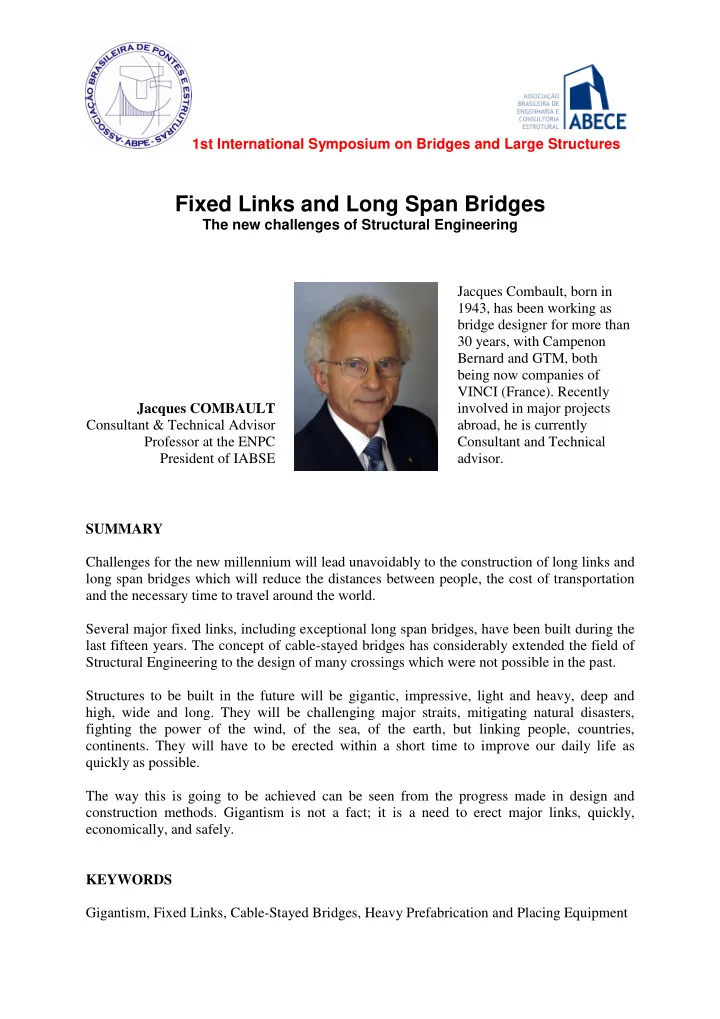

1st International Symposium on Bridges and Large Structures Fixed Links and Long Span Bridges The new challenges of Structural Engineering Jacques Combault, born in 1943, has been working as bridge designer for more than 30 years, with Campenon Bernard and GTM, both being now companies of VINCI (France). Recently involved in major projects Jacques COMBAULT Consultant & Technical Advisor abroad, he is currently Professor at the ENPC Consultant and Technical President of IABSE advisor. SUMMARY Challenges for the new millennium will lead unavoidably to the construction of long links and long span bridges which will reduce the distances between people, the cost of transportation and the necessary time to travel around the world. Several major fixed links, including exceptional long span bridges, have been built during the last fifteen years. The concept of cable-stayed bridges has considerably extended the field of Structural Engineering to the design of many crossings which were not possible in the past. Structures to be built in the future will be gigantic, impressive, light and heavy, deep and high, wide and long. They will be challenging major straits, mitigating natural disasters, fighting the power of the wind, of the sea, of the earth, but linking people, countries, continents. They will have to be erected within a short time to improve our daily life as quickly as possible. The way this is going to be achieved can be seen from the progress made in design and construction methods. Gigantism is not a fact; it is a need to erect major links, quickly, economically, and safely. KEYWORDS Gigantism, Fixed Links, Cable-Stayed Bridges, Heavy Prefabrication and Placing Equipment
1st International Symposium on Bridges and Large Structures CONTENTS ******************* 1. Introduction .............................................................................................................................................- 2 - 2. The Confederation Bridge (P.E.I – Canada).........................................................................................- 2 - 2.1. Approaches ......................................................................................................................................- 3 - 2.1.1. Design .........................................................................................................................................- 3 - 2.1.2. Construction................................................................................................................................- 3 - 2.2. Main Bridge .....................................................................................................................................- 4 - 2.2.1. Major Characteristics ..................................................................................................................- 4 - 2.2.2. Conceptual design .......................................................................................................................- 5 - 2.2.3. Prefabrication..............................................................................................................................- 5 - 2.2.4. Marine operations........................................................................................................................- 6 - 2.2.5. Experience gained in the field of deep water crossing ................................................................- 9 - 3. The Vasco de Gama Bridge ....................................................................................................................- 9 - 3.1. Approaches and Access Viaducts.....................................................................................................- 9 - 3.2. Cable-Stayed Bridge......................................................................................................................- 10 - 4. Development of Cable-Stayed Bridges.................................................................................................- 10 - 4.1. Prestressed Concrete Cable-Stayed Bridges..................................................................................- 11 - 4.1.1. The Pasco-Kennewick Bridge (Washington State – USA) .......................................................- 11 - 4.1.2. The Brotonne Bridge (France) ..................................................................................................- 12 - 4.1.3. The Coatzacoalcos Bridge (Mexico).........................................................................................- 12 - 4.1.4. The Sunshine Skyway Bridge (Florida –USA) .........................................................................- 13 - 4.1.5. The Iroise Bridge (France) ........................................................................................................- 13 - 4.2. Small and Medium Span Concrete Bridges....................................................................................- 14 - 4.3. Long Span Composite Steel-Concrete Cable-Stayed Bridges........................................................- 15 - 4.3.1. The Second Severn Crossing (UK) ...........................................................................................- 15 - 4.3.2. The Normandy Bridge (France) ................................................................................................- 15 - 4.3.3. The Clark Bridge (IL – USA)....................................................................................................- 16 - 4.3.4. The Charles River Bridge (MA – USA)....................................................................................- 17 - 4.4. Exceptional Achievements and New Trends...................................................................................- 17 - 4.4.1. The Rion-Antirion Bridge (Greece) ..........................................................................................- 17 - 4.4.2. The Millau Viaduct (France).....................................................................................................- 18 - 4.4.3. Other Major Achievements .......................................................................................................- 18 - 4.5. Conclusions....................................................................................................................................- 19 - J. Combault – Fixed Links and Long Span Bridges - 1 -
1st International Symposium on Bridges and Large Structures 1. Introduction As shown in the previous part of this document, pre-assembly of typical prefabricated segments, leading to the progressive placement of large components and shorten construction period, was the result of a search for feasibility, erection speed and quality [1]. Indeed, competition, between huge and small precast concrete components to build the large bridges which were needed everywhere in the world, started at the end of the seventies. Building bridges by using heavy precast units and a powerful moving, lifting and placing equipment, a technique which associates the basic principles of prefabrication and displacement methods, lead in the last ten years to the completion of several gigantic and impressive links built at a pace never reached before. At the same time, the extension of traditional construction processes to the construction of long span cable-stayed bridges, progressively made some of these links feasible at a reasonable cost, as long as it was possible to eliminate expensive supports in deep water and provide the required clearances. Figure 1 : The StoreBaelt Within less than ten years, several major fixed links (Figure 1) associating short span bridges to medium or long span bridges were built in adverse environments thanks to the power of engines, computers and communication technology. 2. The Confederation Bridge (P.E.I – Canada) The Prince Edward Island (P.E.I), is located south of Gulf of St Lawrence, east of New Brunswick, mainland Canada, The concrete bridge structure, joining the island and the mainland, crosses the Northumberland Strait at its narrowest point; it is about 13 kilometres long [1]. Due to the unusual characteristics of the Northumberland strait, which is jammed with ice between December and April, the bridge is probably the longest bridge in the world across ice-covered water and both design and construction of the new crossing have had to take into account the extremes of weather that are experienced in this region of North America. J. Combault – Fixed Links and Long Span Bridges - 2 -
Recommend
More recommend